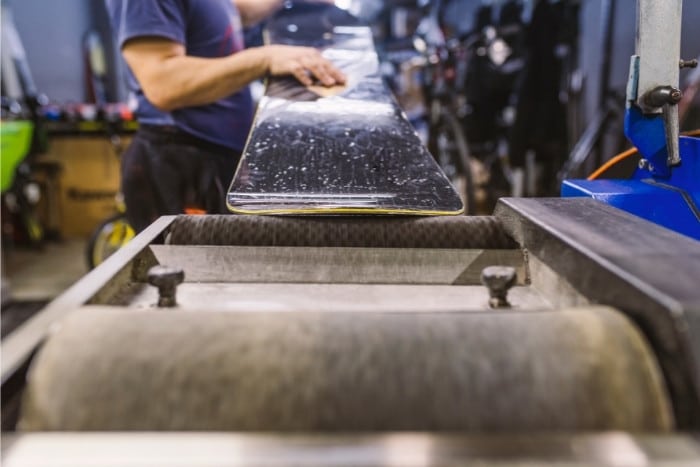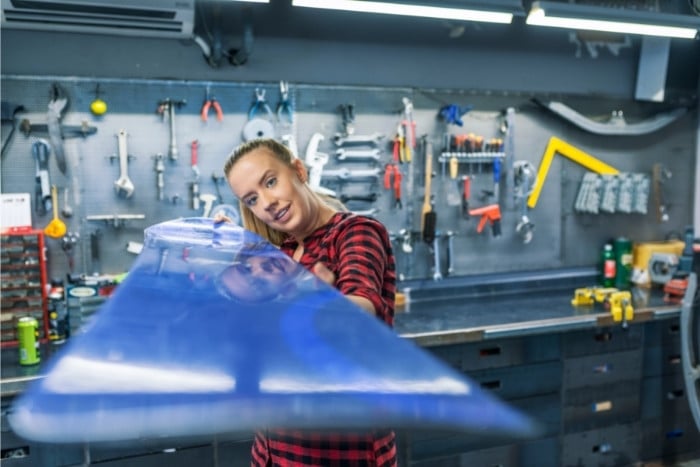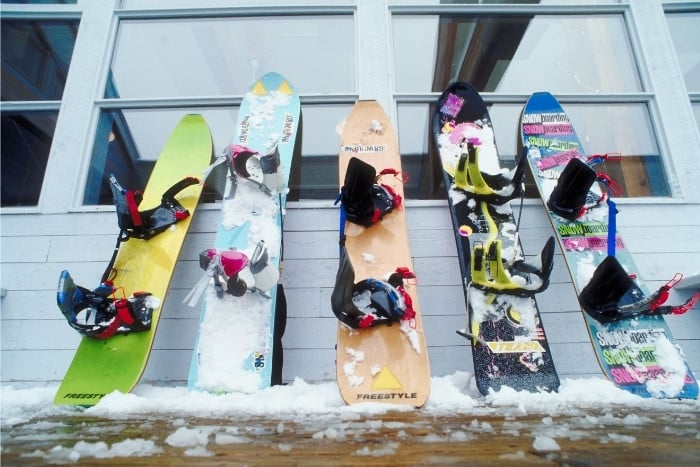It can be tempting to buy an exotically shaped snowboard or one that you’ve seen a pro-rider perform impossible-looking tricks on. But, you need to know if the snowboard you have your eye on is the right one for you.
The snowboard you choose does make a difference to your riding. The varying shapes, stiffness ratings, and profiles give snowboards specific characteristics to suit your skills and riding style. Choosing the right snowboard will allow you to perform at your best and have maximum fun.
Personally, I have a whole quiver of snowboards. Each performs differently with a unique feel, and I choose between them depending on my mood and the snow conditions. Let’s look at what affects how a snowboard performs!
The Characteristics of Different Types Of Snowboards
At first glance, you may struggle to see the difference between snowboards other than their graphics. However, several factors differentiate them.
Here are the characteristics you need to know about what makes a snowboard ride as it does.
1. The Snowboard’s Profile
A snowboard’s profile gives it specific riding characteristics. The various profiles make a difference in how well the board holds an edge, its ride quality, its purpose, and what conditions it’s best suited to.
Here are the main types of snowboard profiles you’ll come across.

Camber
Cambered snowboards are great for riding fast, as the shape gives you superior edge hold. They work well on firm or icy snow while providing lots of stability.
A cambered snowboard’s profile arcs downwards, lifting the center off the ground. It touches the ground at two contact points close to where the tip and tail curve upwards.
Rocker
A rocker snowboard is the opposite of a cambered board. These snowboards curve upwards like a banana when you place them on the ground.
The curvy shape means that most of your weight is on the center of the board, making it forgiving and easy to ride, with little chance of you catching an edge.
In addition, rockers give you a surfy feel when you ride, especially in powder.
Rocker/Camber
A rocker camber snowboard mainly has a cambered shape but has a rocker-like lift at each end. When you ride a rocker/camber snowboard, you will experience excellent edge hold and a smooth ride.
Flat Base
A flat base profile sees the entirety of the snowboard’s base in contact with the snow until the nose and tail rise.
Flat bases provide lots of stability and are easy to ride, especially if they have a soft stiffness rating. They are popular with freestyle riders who like to jib, as they have a consistent flex.
2. The Snowboard’s Sidecut Radius
When you look along the edge of a snowboard, you’ll notice that it curves, making the waist thinner than the nose and tail.
This is known as the sidecut, which differs between the types of snowboards available, defining how they turn.
Snowboards have side cuts of varying curvatures and depths, impacting their turning performance. This is because you can only carve along your snowboard’s sidecut radius.
Therefore, if your snowboard has a long sidecut radius, your carve turns will be over a longer distance. But, if it has a shorter and deeper sidecut radius, your carves will be tighter and quicker.
3. The Snowboard’s Stiffness
A snowboard’s flex influences how it rides and is one of the most important aspects to consider before you buy one. This is because stiffness dictates how well it performs and how easy it is to ride.
Stiffer snowboards provide more edge grip and stability at high speeds. Therefore, they are mostly ridden by experienced riders.
Softer snowboards turn easily and are more forgiving, making them popular with beginners and freestylers.
4. How the Snowboard Is Shaped
When looking at all the snowboards stacked up in the shop, you’ll notice several shapes. Each shape gives you a different experience and is for specific purposes.
Understanding a snowboard’s shape will help you to buy one that suits your riding style.

True Twin
A true twin snowboard is symmetrical and has the same flex from nose to tail. Therefore, it rides the same whether riding forwards or backward.
Freestyle riders love true twins as they make riding switch easier, which is important when you jib, or land jumps backward.
Asymmetrical Twin
Asymmetrical twin snowboards are similar to true twins but can feature asymmetrical sidecuts, contact points, and flex.
These snowboards overcome the different feeling between toe and heelside turns that comes with standing on the board sideways.
Directional Twin
A directional twin snowboard looks like a true twin but has the binding holes set back, giving the snowboard a longer nose than the tail.
Directional twins are usually ridden by all-mountain freestylers. They aren’t as easy to ride switch as a true twin but will handle it without too much trouble.
Directional
Directional snowboards perform at their best going forwards and have a longer nose than tail. They can also have different shaped noses and tails but always have a setback stance and a directional camber.
You can ride a directional snowboard switch, but it would be more challenging and have a different feel from riding forwards.
Directional snowboards are ridden mainly by freeriders and all-mountain riders, as they aren’t too bothered about how well their boards ride switch.
Tapered Directional
The main difference between a directional and tapered directional snowboard is that the nose is fatter, longer, and stiffer than the tail.
This allows the tail to sink in the snow, making the nose float, which is enhanced by a setback stance. These characteristics make these snowboards excellent in powder.
The shape also allows you to make fast turns around trees.
The Different Types of Snowboards
Now that you know about snowboard characteristics, it’s time to put them all together and look at the different types of snowboards available.
Snowboard manufacturers market these boards to certain types of riders, making the purchasing process a little bit easier. But they are made up of all the characteristics listed above.
So if you’re after a certain characteristic, make sure your type of board has this before buying

1. All-Mountain Snowboards
Most people ride all-mountain snowboards, as they perform well anywhere you ride them. They hit the sweet spot between float in powder, freestyle, and turning performance.
All-mountain snowboards are versatile enough for all abilities. They often have a directional shape and a mid-level flex to cope with everything you experience on the mountain.
2. Freestyle Snowboards
Freestyle snowboards are flexible, short, and forgiving, so it’s easier to perform tricks and land jumps. However, their flexible nature means they can chatter at high speed, making them unstable.
3. Alpine Snowboards
Alpine snowboards are pretty rare in resorts these days but are used for slalom racing. These snowboards are super stiff, directional, and long, so the rider can go as fast as possible and turn hard.
The boots used with alpine snowboards look a bit like ski boots. These hard plastic boots are designed to give the rider ultimate control and leverage for fast turns.
However, alpine snowboards are not very forgiving and are not suitable for any freestyle riding.
4. Freeride
Freeride snowboards are for advanced riders who hunt for powder in the backcountry. These snowboards are designed to go fast and ridden aggressively, so they are stiff and have lots of edge hold.
Final Thoughts
As you can see, the type of snowboard you ride really does matter. Many characteristics affect how snowboards ride, and manufacturers combine them in a way to suit a particular type of riding.
So before you buy a snowboard, consider what kind of snowboarder you want to be. If you’ve found this article helpful, check out more snowboard blogs written by our experts.
